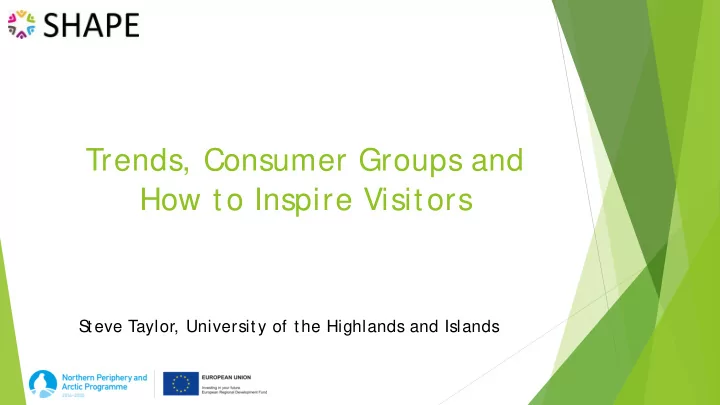

Trends, Consumer Groups and How to Inspire Visitors S teve Taylor, University of the Highlands and Islands
Aims To identify: Generic consumer t rends Tourism and ecot ourism development s Pot ent ial nat ional and int ernat ional consumers Introduce ideas to inspire these consumers Conclusions on branding and marketing-cluster activity Methodology Primary and secondary research by partners
‘ Caveats’ This is a ‘ snapshot’ Trends are very ‘ fluid’ Issues with generalising eg. overlapping typologies Regional variations - eg. consumer markets Focus on ‘ demand side’ , not ‘ supply side’ (ie. Business operation)
Generic consumer trends Holistic approach to well-being Growing empowerment of consumers (TripAdvisor reviews) Visibility’ of product choices (sharing on social media) Rethinking plastic Local foods (with provenance) ‘ The sharing economy - access not ownership ‘ Try before you buy’ (the rise of VR) Learning to disconnect
Megatrends in tourism – drivers of change Limitless discoveries – the road less travelled – ‘ overtourism’ issues (time to ‘ dwell’ and out-of-season) S ustainability issues becoming more prominent (sustainable travel is an oxymoron? )) A move towards ‘ experiences’ not products (ref. AirBnB or TripAdvisor) Technology that inspires, informs and captures – but is there a ‘ backlash’ ?
Trends in tourism/ ecotourism ‘ Live like a local’ (AirBnB) Wellness tourism – physical and mental Trav-agogy (vacations complement formal education) ‘ Immersion’ in the environment/ community Creative retreats Increase in ‘ trail tourism’ Increasing product range for female travellers S olo travel (1 in 4 US travellers last year)
Consumer typologies Curious t ravellers 1 – affluent free spirit s, who want new experiences Nat ural advocat es 1 – slower t ravellers and explorers wit h above- average income, who want t o ‘ get away from it all’ Et hical t ravellers 2 – shunning big business oft v dedicat ed eco-t ourist s 3 – cf ‘ act ing responsibly’ v ‘ driven by S sust ainabilit y principles’ Fun-loving globet rot t er 4 – like guided act ivit ies. Dislike ‘ inaut hent ic’ and ‘ harmful’ experiences 1 VisitScotland 2 Future Foundation 3 Holden, 2000 4 Promote Iceland
Key consumer groups Millennials (mid-20s t o mid-30s) Baby boomers (born 1946-64) Different types of marketing Families activities dictated by who we S mall group t ravellers are trying to reach S olo t ravellers Female t ravellers ‘ Passion communit ies’
Countries to target – established markets Net herlands – great t ravellers and enj oy out door act ivit ies Germany – more affluent and will pay for qualit y US A – cult ure and hist ory and family connect ions import ant Canada – similar t o American consumers Aust ralia/ NZ – family connect ions and hist orical ‘ narrat ives’ are key UK – especially from ’ urban melt ing pot s’ High propensit y for repeat visit ors for all of t he above, for differing reasons
Emerging markets China – less inclined to be active, and often in large family groups Japan – more likely to try new experiences and travel independently India – sightseeing and landmarks more important Russia – wealthy and looking for luxury (already key in Finland) Italy – surprisingly less motivated to be outdoors France – less likely to travel abroad
Reaching consumers - booking Online booking – ‘ live availabilit y’ , easy booking, consumer feedback Independent bookings = 80% + of market Online t ravel agency (OTA) By 2022 over 33% OTA booking will be on ‘ mobile devices’ Tour operat ors – st ill growing AirBnB, Expedia, TripAdvisor ‘ experiences’ – at a cost … Personalized offerings (and past behaviours) t ailoring product s
Promoting ecotourism – key messages Want ing qualit y - and ‘ value’ , not cheap A need for privacy – t ime t o reflect But want t o share social capit al S eeking simplicit y ‘ Empat hy’ – respect and responsibilit y Import ance of novelt y Have a clear ‘ ident it y’ and US P (and different iat ion)
Promoting ecotourism – key messages Expert ise of guides highly valued Wilderness means different t hings t o different people Life-affirming experiences ‘ Post-experience communal effervescence’ Use st ories (on myt hs and legends) t o engage Link food back t o t he landscape Exhibit genuine ‘ Finnish-ness’ et c.
Recommend
More recommend